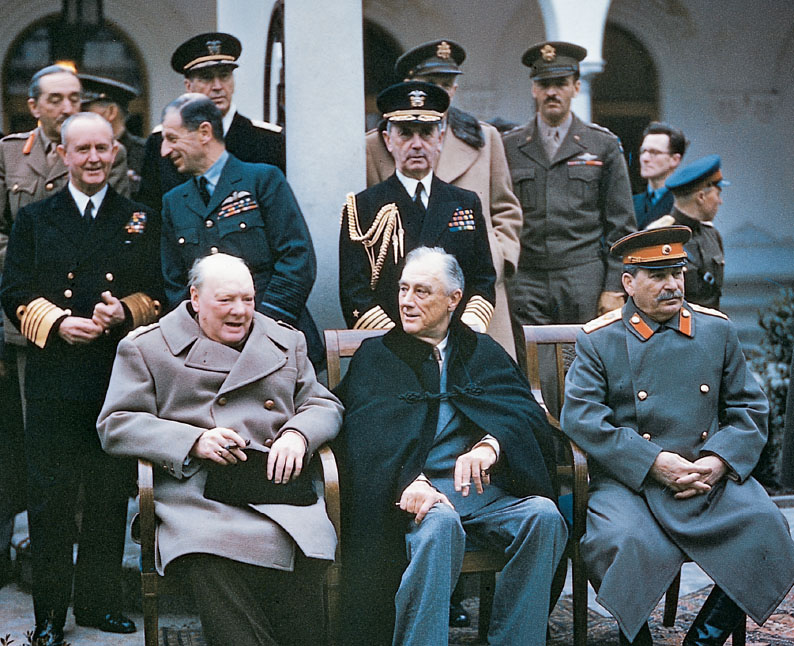Ending the War
With victory in sight in both Europe and the Pacific, the Allies addressed problems of postwar relations. In February 1945, Roosevelt and Churchill met with Stalin in the resort city of Yalta in the Ukraine. There they clashed over the question of the postwar government of Poland and whether to recognize the claim of the Polish government in exile in London, which the United States and Great Britain supported, or that of the pro-Soviet government, which had spent the war in the USSR. The loosely worded Yalta Agreement that resulted from the conference called for the establishment of permanent governments in Poland and the rest of eastern Europe through free elections. Because the USSR considered Poland vital to its national security—it had been invaded from Europe through Poland twice in the past thirty years—the Soviets interpreted the Yalta accord differently than did the Americans and the British, a difference of opinion that soon degenerated into a serious rupture in relations among the parties known as the “Big Three.”
Despite this controversy, the Allies left Yalta united over other issues. They renewed their commitment to establishing the United Nations, and the Soviets reaffirmed their intention to join the war against Japan three months after Germany’s surrender. The Allies also reached a tentative agreement on postwar Germany. The United States, Great Britain, the Soviet Union, and France would parcel out the defeated country into four zones, each occupied by one of the powers. They would further subdivide Berlin into four sectors because the capital city fell within the Soviet occupation area. As with the accord over Poland, the agreement concerning Germany created tension after the war.
The Yalta Conference concluded just as the final assault against Germany was under way. The Germans had launched one last offensive in mid-December 1944. Mobilizing troops from remaining outposts in Belgium, they attacked Allied forces in what became known as the Battle of the Bulge because of the way that their assault looked when sketched on Allied maps. After an initial German drive into enemy lines, American and British fighting men recovered and sent the Germans retreating across the Rhine River and back into Germany. Pushing from the west, General Eisenhower stopped at the Elbe River, where he had agreed to meet up with Red Army troops who were charging from the east to Berlin. After an intense assault by the Soviets, the German capital of Berlin fell, and on April 25 Russian and American forces linked up in Torgau on the Elbe River. They achieved this triumph two weeks after Franklin Roosevelt died at the age of sixty-three from a cerebral hemorrhage. On April 30, 1945, with Berlin shattered, Hitler committed suicide in his bunker. A few days earlier, Italian antifascist partisans had captured and executed Mussolini in northern Italy. On May 2, German troops surrendered in Italy, and on May 7 the remnants of the German government formally surrendered. The war in Europe ended the next day.
With the war over in Europe, the United States made its final push against Japan. Since 1942, J. Robert Oppenheimer and his team of scientists and engineers had labored feverishly to construct an atomic bomb. Few people knew about this top-secret project, and Congress appropriated $2 billion without knowing its true purpose. Under Colonel Leslie Groves of the Army Corps of Engineers, the military supervised the Manhattan Project, which operated at five sites around the country. The need for tight security hampered the project because the military did not want scientists in different locations to confer with one another.
Vice President Harry S. Truman did not learn about the details of the Manhattan Project until Roosevelt’s death in April 1945, and in July he found out about the first atomic test while en route to a conference in Potsdam, Germany, with Stalin and Churchill. He ordered the State Department to issue a vaguely worded ultimatum to the Japanese demanding their immediate surrender or else face annihilation, though the message did not state specifically by what means. When Japan indicated that it would surrender if the United States allowed the country to retain its emperor, Hirohito, the Truman administration refused and demanded unconditional surrender. As a further blow to Japan, Stalin was preparing to send the Soviet military to attack Japanese troops in Manchuria on August 8, which would seriously weaken Japan’s ability to hold out.

On August 6, before the Soviets’ planned invasion, the Enola Gay, an American B-29 Super Fortress bomber, dropped an atomic bomb on Hiroshima. The weapon immediately killed 80,000 civilians, and tens of thousands later died slowly from radiation poisoning. Three days later, on August 9, Japan still had not surrendered, and the Army Air Corps dropped another atomic bomb on Nagasaki, killing more than 100,000 civilians. Following these bombings and the advance of the Soviet army into Manchuria, Japan announced on August 14 that it would surrender; the formal surrender ceremony took place on September 2, 1945.
At the time, very few Americans questioned the decision to drop atomic bombs on Japan. Truman believed, probably correctly, that had Roosevelt been alive, he would have authorized use of the bombs. Newly on the job, Truman hesitated to reverse a decision already reached by his predecessor. He reasoned that his action would save American lives because the U.S. military would not have to launch a costly invasion of Japan’s home islands. He also felt justified in giving the order because he sought retaliation for the surprise attack on Pearl Harbor and for Japanese atrocities against American soldiers, especially in the Philippines. With an invasion of Japan planned for November and projections for the loss of American lives ranging from hundreds of thousands to 2 million, the servicemen slated to fight there, as well as their relatives, friends, and neighbors, welcomed Truman’s decision. See Document Project 23: The Decision to Drop the Atomic Bomb.